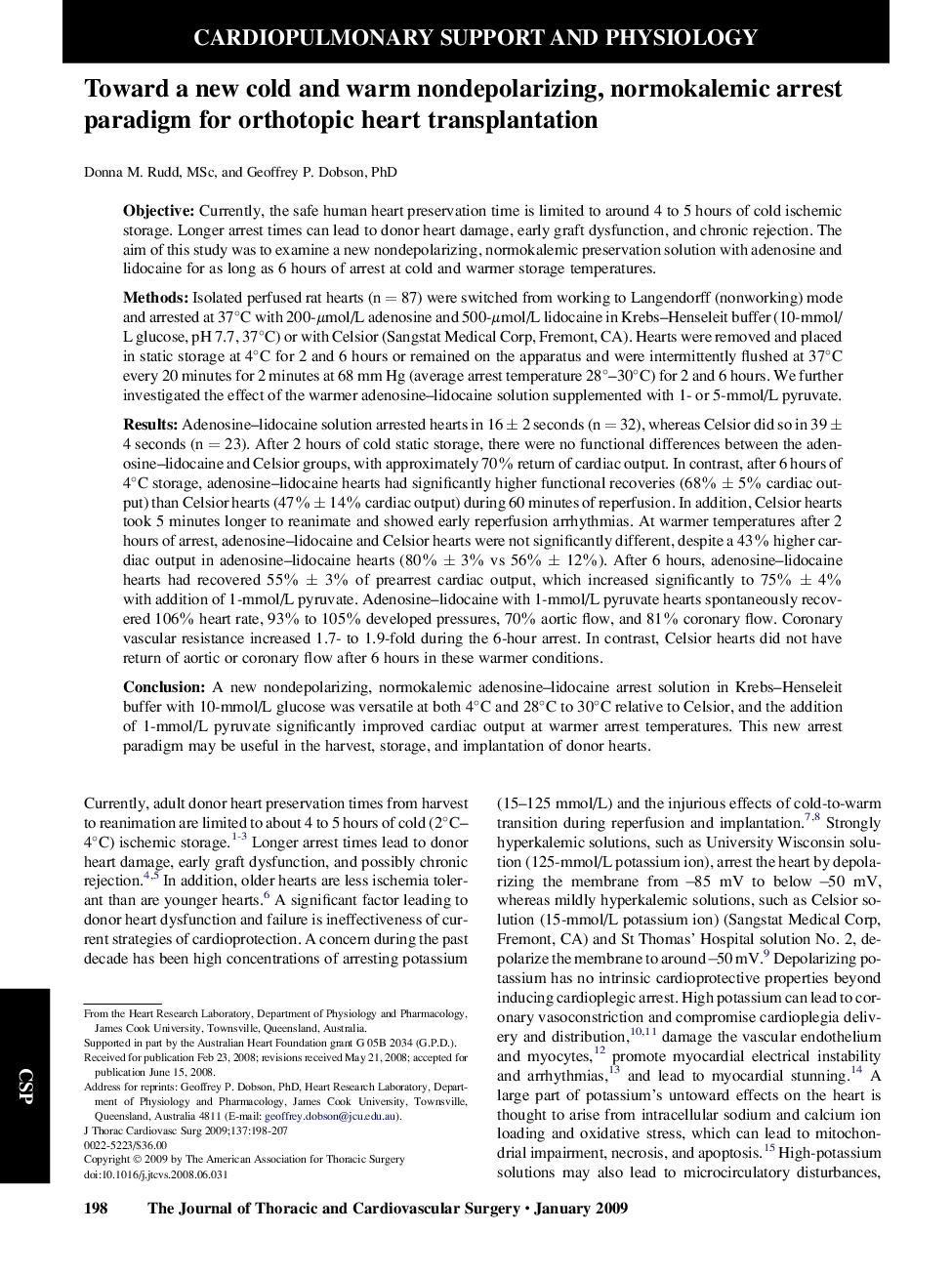| کد مقاله | کد نشریه | سال انتشار | مقاله انگلیسی | نسخه تمام متن |
|---|---|---|---|---|
| 2982011 | 1578678 | 2009 | 10 صفحه PDF | دانلود رایگان |

ObjectiveCurrently, the safe human heart preservation time is limited to around 4 to 5 hours of cold ischemic storage. Longer arrest times can lead to donor heart damage, early graft dysfunction, and chronic rejection. The aim of this study was to examine a new nondepolarizing, normokalemic preservation solution with adenosine and lidocaine for as long as 6 hours of arrest at cold and warmer storage temperatures.MethodsIsolated perfused rat hearts (n = 87) were switched from working to Langendorff (nonworking) mode and arrested at 37°C with 200-μmol/L adenosine and 500-μmol/L lidocaine in Krebs–Henseleit buffer (10-mmol/L glucose, pH 7.7, 37°C) or with Celsior (Sangstat Medical Corp, Fremont, CA). Hearts were removed and placed in static storage at 4°C for 2 and 6 hours or remained on the apparatus and were intermittently flushed at 37°C every 20 minutes for 2 minutes at 68 mm Hg (average arrest temperature 28°–30°C) for 2 and 6 hours. We further investigated the effect of the warmer adenosine–lidocaine solution supplemented with 1- or 5-mmol/L pyruvate.ResultsAdenosine–lidocaine solution arrested hearts in 16 ± 2 seconds (n = 32), whereas Celsior did so in 39 ± 4 seconds (n = 23). After 2 hours of cold static storage, there were no functional differences between the adenosine–lidocaine and Celsior groups, with approximately 70% return of cardiac output. In contrast, after 6 hours of 4°C storage, adenosine–lidocaine hearts had significantly higher functional recoveries (68% ± 5% cardiac output) than Celsior hearts (47% ± 14% cardiac output) during 60 minutes of reperfusion. In addition, Celsior hearts took 5 minutes longer to reanimate and showed early reperfusion arrhythmias. At warmer temperatures after 2 hours of arrest, adenosine–lidocaine and Celsior hearts were not significantly different, despite a 43% higher cardiac output in adenosine–lidocaine hearts (80% ± 3% vs 56% ± 12%). After 6 hours, adenosine–lidocaine hearts had recovered 55% ± 3% of prearrest cardiac output, which increased significantly to 75% ± 4% with addition of 1-mmol/L pyruvate. Adenosine–lidocaine with 1-mmol/L pyruvate hearts spontaneously recovered 106% heart rate, 93% to 105% developed pressures, 70% aortic flow, and 81% coronary flow. Coronary vascular resistance increased 1.7- to 1.9-fold during the 6-hour arrest. In contrast, Celsior hearts did not have return of aortic or coronary flow after 6 hours in these warmer conditions.ConclusionA new nondepolarizing, normokalemic adenosine–lidocaine arrest solution in Krebs–Henseleit buffer with 10-mmol/L glucose was versatile at both 4°C and 28°C to 30°C relative to Celsior, and the addition of 1-mmol/L pyruvate significantly improved cardiac output at warmer arrest temperatures. This new arrest paradigm may be useful in the harvest, storage, and implantation of donor hearts.
Journal: The Journal of Thoracic and Cardiovascular Surgery - Volume 137, Issue 1, January 2009, Pages 198–207